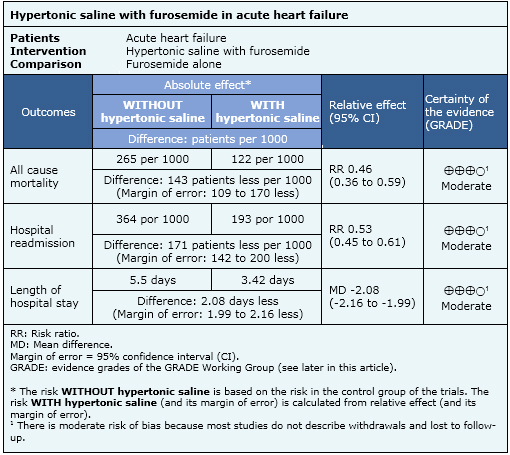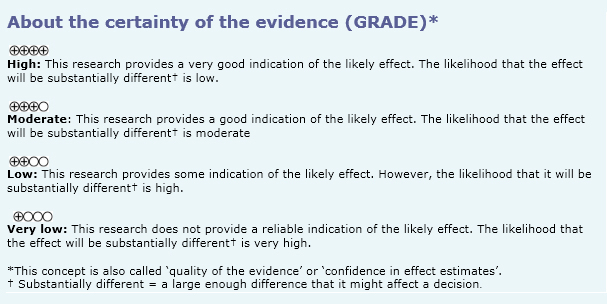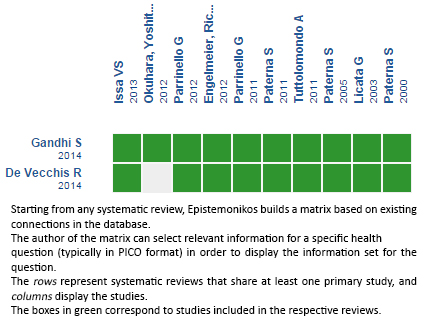 Para Descargar PDF debe Abrir sesión.
Para Descargar PDF debe Abrir sesión.
In search of new therapies to solve diuretic resistance in acute heart failure, the addition of hypertonic saline has been proposed. Searching in Epistemonikos database, which is maintained by screening 30 databases, we identified two systematic reviews including nine pertinent randomized controlled trials. We combined the evidence and generated a summary of findings following the GRADE approach. We concluded hypertonic saline associated with furosemide probably decrease mortality, length of hospital stay and hospital readmission in patients with acute decompensated heart failure.
Volume depletion is the mainstay of treatment for acute heart failure, mainly with loop diuretics such as furosemide. However, some patients develop resistance to diuretics. Among the alternatives that have arisen as a potential solution to this clinical problem is the use of hypertonic saline. The increase in plasma osmolarity allows mobilization of extracellular fluid into intravascular. As baroceptors sense intravascular expansion, peripheral resistance decreases, improving ejection fraction, therefore increasing kidney and other organs blood flow, which improves response to diuretics. In addition, animal studies show hypertonic saline alone could improve myocardial contractility and reduce proinflammatory factors.
We used Epistemonikos database, which is maintained by screening more than 30 databases, to identify systematic reviews and their included primary studies. With this information we generated a structured summary using a pre-established format, which includes key messages, a summary of the body of evidence (presented as an evidence matrix in Epistemonikos), meta-analysis of the total of studies, a summary of findings table following the GRADE approach and a table of other considerations for decision-making.
|
Key messages
|
|
What is the evidence. |
We found two systematic reviews [1],[2] including nine randomized controlled trials reported in 10 references [3],[4],[5],[6],[7],[8],[9],[10],[11],[12]. |
|
What types of patients were included |
All studies included patients with heart failure; six of them had reduced ejection fraction as inclusion criteria: three with <45% [4],[6],[7], three with <40% [8],[11],[12] and one with <35% [9],[10]. Three studies required patients were refractory to standard treatment [4],[7],[9],[10]. Seven studies restricted inclusion to patients with preserved renal function: three of them set creatinine limit in 2 mg/dl and without previous consumption of non-steroidal anti-inflammatories [4],[7],[9],[10]. |
|
What types of interventions were included |
Hypertonic saline in various concentrations, adjusted according sodium plasma level in five studies [4],[6],[8],[9],[10],[11], combined with intravenous furosemide in doses ranging from 250 to 2000 mg/day, administered either as bolus or continuous infusion. All studies compared with furosemide alone that was administered in the same way and dose as in the group intervened. |
|
What types of outcomes |
All-cause mortality, mortality from heart failure, need for hospitalization, length of hospital stay, change in New York Heart Association (NYHA) classification, renal function, cardiac markers, body weight. |
Information on the effects of adding hypertonic saline to the treatment with furosemide is based on nine randomized trials including 2566 patients. Only four studies reported overall mortality [4],[8],[10],[12], three studies reported readmissions [4],[8],[10], six studies reported length of hospital stay [4],[6],[7],[8],[10],[11] and seven studies reported change in creatinine serum level [3],[4],[6],[7],[8],[10],[12].


|
To whom this evidence does and does not apply |
|
| About the outcomes included in this summary |
| Balance between benefits and risks, and certainty of the evidence |
|
| Resource considerations |
|
|
Differences between this summary and other sources |
|
| Could this evidence change in the future? |
|
Using automated and collaborative means, we compiled all the relevant evidence for the question of interest and we present it as a matrix of evidence.
Matrix of evidence (static version).
Follow the link to access the interactive version: Hypertonic saline plus furosemide for acute heart failure
The upper portion of the matrix of evidence will display a warning of “new evidence” if new systematic reviews are published after the publication of this summary. Even though the project considers the periodical update of these summaries, users are invited to comment in Medwave or to contact the authors through email if they find new evidence and the summary should be updated earlier. After creating an account in Epistemonikos, users will be able to save the matrixes and to receive automated notifications any time new evidence potentially relevant for the question appears.
The details about the methods used to produce these summaries are described here http://dx.doi.org/10.5867/medwave.2014.06.5997.
Epistemonikos foundation is a non-for-profit organization aiming to bring information closer to health decision-makers with technology. Its main development is Epistemonikos database (www.epistemonikos.org).
These summaries follow a rigorous process of internal peer review.
Conflicts of interest
The authors do not have relevant interests to declare.

 Matrix of evidence (static version).
Matrix of evidence (static version).
 Esta obra de Medwave está bajo una licencia Creative Commons Atribución-NoComercial 3.0 Unported. Esta licencia permite el uso, distribución y reproducción del artículo en cualquier medio, siempre y cuando se otorgue el crédito correspondiente al autor del artículo y al medio en que se publica, en este caso, Medwave.
Esta obra de Medwave está bajo una licencia Creative Commons Atribución-NoComercial 3.0 Unported. Esta licencia permite el uso, distribución y reproducción del artículo en cualquier medio, siempre y cuando se otorgue el crédito correspondiente al autor del artículo y al medio en que se publica, en este caso, Medwave.

In search of new therapies to solve diuretic resistance in acute heart failure, the addition of hypertonic saline has been proposed. Searching in Epistemonikos database, which is maintained by screening 30 databases, we identified two systematic reviews including nine pertinent randomized controlled trials. We combined the evidence and generated a summary of findings following the GRADE approach. We concluded hypertonic saline associated with furosemide probably decrease mortality, length of hospital stay and hospital readmission in patients with acute decompensated heart failure.
 Autores:
Patricio Zepeda[1,3], Carmen Rain[1,3], Paola Sepúlveda[2,3]
Autores:
Patricio Zepeda[1,3], Carmen Rain[1,3], Paola Sepúlveda[2,3]

Citación: Zepeda P, Rain C, Sepúlveda P. What are the effects of hypertonic saline plus furosemide in acute heart failure?. Medwave 2015 Ago;15(Suppl 2):e6233 doi: 10.5867/medwave.2015.6233
Fecha de publicación: 27/8/2015

Nos complace que usted tenga interés en comentar uno de nuestros artículos. Su comentario será publicado inmediatamente. No obstante, Medwave se reserva el derecho a eliminarlo posteriormente si la dirección editorial considera que su comentario es: ofensivo en algún sentido, irrelevante, trivial, contiene errores de lenguaje, contiene arengas políticas, obedece a fines comerciales, contiene datos de alguna persona en particular, o sugiere cambios en el manejo de pacientes que no hayan sido publicados previamente en alguna revista con revisión por pares.
Nombre/name: Jose Luis Morales
Fecha/date: 2016-10-29 20:06:03
Comentario/comment:
Sin duda es una terapia interesante para el manejo de la insuficiencia cardiaca agudizada en pacientes que ya están recibiendo diuréticos de asa.
Nuestra experiencia clÃnica es muy favorable y subjetivamente es una terapia que cuesta no aplicar una vez se inicia. Incluso es percibido por el propio paciente.
Llama la atención que con el grado de evidencia que hay no se haya desarrollado nada al respecto en las últimas guÃas de práctica clÃnica para insuficiencia cardiaca europeas de 2016 - la certeza de la evidencia serÃa suficiente.
Hay un detalle a comentar, si nos fijamos en la bibliografÃa los autores son siempre los mismos por lo tanto el valor de los metaanalisis a nuestro juicio es relativo dado que parece que son los mismos autores replicando resultados en poblaciones similares.
Gracias por esta excelente revisión.
Saludos.
José Luis Morales-Rull
Servicio de Medicina Interna
Hospital Universitario Arnau de Vilanova
Unidad de Insuficiencia Cardiaca
Región Sanitaria de Lleida
España
Para comentar debe iniciar sesión
 Medwave publica las vistas HTML y descargas PDF por artículo, junto con otras métricas de redes sociales.
Medwave publica las vistas HTML y descargas PDF por artículo, junto con otras métricas de redes sociales.
 Gandhi S, Mosleh W, Myers RB. Hypertonic saline with furosemide for the treatment of acute congestive heart failure: a systematic review and meta-analysis. Int J Cardiol. 2014 May 1;173(2):139-45. | CrossRef | PubMed |
Gandhi S, Mosleh W, Myers RB. Hypertonic saline with furosemide for the treatment of acute congestive heart failure: a systematic review and meta-analysis. Int J Cardiol. 2014 May 1;173(2):139-45. | CrossRef | PubMed | De Vecchis R, Esposito C, Ariano C, Cantatrione S. Hypertonic saline plus i.v. furosemide improve renal safety profile and clinical outcomes in acute decompensated heart failure: A meta-analysis of the literature. Herz. 2015 May;40(3):423-35. | CrossRef | PubMed |
De Vecchis R, Esposito C, Ariano C, Cantatrione S. Hypertonic saline plus i.v. furosemide improve renal safety profile and clinical outcomes in acute decompensated heart failure: A meta-analysis of the literature. Herz. 2015 May;40(3):423-35. | CrossRef | PubMed | Engelmeier RS, Le TT, Kamalay SE, Utecht KN, Nikstad TP, Kaliebe JW, et al. Randomized trial of high dose furosemide-hypertonic Saline in acute decompesated heart Failure with advanced renal disease. Jounal Am Coll Cardiol. 2012;59(13s1):E958–E958.
| Link |
Engelmeier RS, Le TT, Kamalay SE, Utecht KN, Nikstad TP, Kaliebe JW, et al. Randomized trial of high dose furosemide-hypertonic Saline in acute decompesated heart Failure with advanced renal disease. Jounal Am Coll Cardiol. 2012;59(13s1):E958–E958.
| Link | Licata G, Di Pasquale P, Parrinello G, Cardinale A, Scandurra A, Follone G, et al. Effects of high-dose furosemide and small-volume hypertonic saline solution infusion in comparison with a high dose of furosemide as bolus in refractory congestive heart failure: long-term effects. Am Heart J. 2003 Mar;145(3):459-66. | PubMed |
Licata G, Di Pasquale P, Parrinello G, Cardinale A, Scandurra A, Follone G, et al. Effects of high-dose furosemide and small-volume hypertonic saline solution infusion in comparison with a high dose of furosemide as bolus in refractory congestive heart failure: long-term effects. Am Heart J. 2003 Mar;145(3):459-66. | PubMed | Okuhara Y, Hirotani S, Naito Y, Iwasaku T, Eguchi A, Sawada H, et al. Impact of Concomitant Administration Hypertonic Saline Solution and Daily Use Furosemide in Treatment of Acute Decompensated Heart Failure: Abstract 12149. Cardiology. 2012;126(21 Supplement). | Link |
Okuhara Y, Hirotani S, Naito Y, Iwasaku T, Eguchi A, Sawada H, et al. Impact of Concomitant Administration Hypertonic Saline Solution and Daily Use Furosemide in Treatment of Acute Decompensated Heart Failure: Abstract 12149. Cardiology. 2012;126(21 Supplement). | Link | Parrinello G, Di Pasquale P, Torres D, Cardillo M, Schimmenti C, Lupo U, et al. Troponin I release after intravenous treatment with high furosemide doses plus hypertonic saline solution in decompensated heart failure trial (Tra-HSS-Fur). Am Heart J. 2012 Sep;164(3):351-7. | CrossRef | PubMed |
Parrinello G, Di Pasquale P, Torres D, Cardillo M, Schimmenti C, Lupo U, et al. Troponin I release after intravenous treatment with high furosemide doses plus hypertonic saline solution in decompensated heart failure trial (Tra-HSS-Fur). Am Heart J. 2012 Sep;164(3):351-7. | CrossRef | PubMed | Parrinello G, Paterna S, Di Pasquale P, Torres D, Mezzero M, Cardillo M, et al. Changes in estimating echocardiography pulmonary capillary wedge pressure after hypersaline plus furosemide versus furosemide alone in decompensated heart failure. J Card Fail. 2011 Apr;17(4):331-9. | CrossRef | PubMed |
Parrinello G, Paterna S, Di Pasquale P, Torres D, Mezzero M, Cardillo M, et al. Changes in estimating echocardiography pulmonary capillary wedge pressure after hypersaline plus furosemide versus furosemide alone in decompensated heart failure. J Card Fail. 2011 Apr;17(4):331-9. | CrossRef | PubMed | Paterna S, Fasullo S, Parrinello G, Cannizzaro S, Basile I, Vitrano G, et al. Short-term effects of hypertonic saline solution in acute heart failure and long-term effects of a moderate sodium restriction in patients with compensated heart failure with New York Heart Association class III (Class C) (SMAC-HF Study). Am J Med Sci. 2011 Jul;342(1):27-37. | CrossRef | PubMed |
Paterna S, Fasullo S, Parrinello G, Cannizzaro S, Basile I, Vitrano G, et al. Short-term effects of hypertonic saline solution in acute heart failure and long-term effects of a moderate sodium restriction in patients with compensated heart failure with New York Heart Association class III (Class C) (SMAC-HF Study). Am J Med Sci. 2011 Jul;342(1):27-37. | CrossRef | PubMed | Paterna S, Di Pasquale P, Parrinello G, Amato P, Cardinale A, Follone G, et al. Effects of high-dose furosemide and small-volume
hypertonic saline solution infusion in comparison with a high dose of furosemide as a bolus, in refractory congestive heart failure. Eur J Heart Fail. 2000 Sep;2(3):305-13. | PubMed |
Paterna S, Di Pasquale P, Parrinello G, Amato P, Cardinale A, Follone G, et al. Effects of high-dose furosemide and small-volume
hypertonic saline solution infusion in comparison with a high dose of furosemide as a bolus, in refractory congestive heart failure. Eur J Heart Fail. 2000 Sep;2(3):305-13. | PubMed | Paterna S, Di Pasquale P, Parrinello G, Fornaciari E, Di Gaudio F, Fasullo S, et al. Changes in brain natriuretic peptide levels and bioelectrical impedance measurements after treatment with high-dose furosemide and hypertonic saline solution versus high-dose furosemide alone in refractory congestive heart failure: a double-blind study. J Am Coll Cardiol. 2005 Jun 21;45(12):1997-2003. | PubMed |
Paterna S, Di Pasquale P, Parrinello G, Fornaciari E, Di Gaudio F, Fasullo S, et al. Changes in brain natriuretic peptide levels and bioelectrical impedance measurements after treatment with high-dose furosemide and hypertonic saline solution versus high-dose furosemide alone in refractory congestive heart failure: a double-blind study. J Am Coll Cardiol. 2005 Jun 21;45(12):1997-2003. | PubMed | Tuttolomondo A, Pinto A, Di Raimondo D, Corrao S, Di Sciacca R, Scaglione R, et al. Changes in natriuretic peptide and cytokine plasma levels in patients with heart failure, after treatment with high dose of furosemide plus hypertonic saline solution (HSS) and after a saline loading. Nutr Metab Cardiovasc Dis. 2011 May;21(5):372-9. | CrossRef | PubMed |
Tuttolomondo A, Pinto A, Di Raimondo D, Corrao S, Di Sciacca R, Scaglione R, et al. Changes in natriuretic peptide and cytokine plasma levels in patients with heart failure, after treatment with high dose of furosemide plus hypertonic saline solution (HSS) and after a saline loading. Nutr Metab Cardiovasc Dis. 2011 May;21(5):372-9. | CrossRef | PubMed | Issa VS, Andrade L, Ayub-Ferreira SM, Bacal F, de Bragança AC, Guimarães GV, et al. Hypertonic saline solution for prevention of renal dysfunction in patients with decompensated heart failure. Int J Cardiol. 2013 Jul 15;167(1):34-40. | CrossRef | PubMed |
Issa VS, Andrade L, Ayub-Ferreira SM, Bacal F, de Bragança AC, Guimarães GV, et al. Hypertonic saline solution for prevention of renal dysfunction in patients with decompensated heart failure. Int J Cardiol. 2013 Jul 15;167(1):34-40. | CrossRef | PubMed | Lindenfeld J, Albert NM, Boehmer JP, Collins SP, Ezekowitz JA, Givertz MM, et al. HFSA 2010 Comprehensive Heart Failure Practice Guideline. J Card Fail [Internet]. 2010 Jun;16(6):e1–194. | Link |
Lindenfeld J, Albert NM, Boehmer JP, Collins SP, Ezekowitz JA, Givertz MM, et al. HFSA 2010 Comprehensive Heart Failure Practice Guideline. J Card Fail [Internet]. 2010 Jun;16(6):e1–194. | Link | Moe GW, Ezekowitz JA, O’Meara E, Lepage S, Howlett JG, Fremes S, et al. The 2014 Canadian Cardiovascular Society Heart Failure Management Guidelines Focus Update: anemia, biomarkers, and recent therapeutic trial implications. Can J Cardiol. Elsevier; 2015 Jan 1;31(1):3–16. | Link |
Moe GW, Ezekowitz JA, O’Meara E, Lepage S, Howlett JG, Fremes S, et al. The 2014 Canadian Cardiovascular Society Heart Failure Management Guidelines Focus Update: anemia, biomarkers, and recent therapeutic trial implications. Can J Cardiol. Elsevier; 2015 Jan 1;31(1):3–16. | Link | Yancy CW, Jessup M, Bozkurt B, Butler J, Casey DE, Drazner MH, et al. 2013 ACCF/AHA guideline for the management of heart failure: a report of the American College of Cardiology Foundation/American Heart Association Task Force on practice guidelines. Circulation. 2013 Oct 15;128(16):e240–327. | Link |
Yancy CW, Jessup M, Bozkurt B, Butler J, Casey DE, Drazner MH, et al. 2013 ACCF/AHA guideline for the management of heart failure: a report of the American College of Cardiology Foundation/American Heart Association Task Force on practice guidelines. Circulation. 2013 Oct 15;128(16):e240–327. | Link | McMurray JJ V, Adamopoulos S, Anker SD, Auricchio A, Böhm M, Dickstein K, et al. ESC Guidelines for the diagnosis and treatment of acute and chronic heart failure 2012: The Task Force for the Diagnosis and Treatment of Acute and Chronic Heart Failure 2012 of the European Society of Cardiology. Developed in collaboration with the Heart. Eur Heart J. 2012 Jul;33(14):1787–847. | Link |
McMurray JJ V, Adamopoulos S, Anker SD, Auricchio A, Böhm M, Dickstein K, et al. ESC Guidelines for the diagnosis and treatment of acute and chronic heart failure 2012: The Task Force for the Diagnosis and Treatment of Acute and Chronic Heart Failure 2012 of the European Society of Cardiology. Developed in collaboration with the Heart. Eur Heart J. 2012 Jul;33(14):1787–847. | Link |